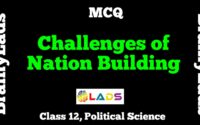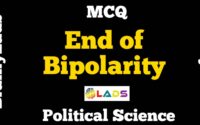MCQ of Planning And Development | Class 12 | Political Science | Term 1 |
MCQ of Planning And Development | Class 12 | Political Science | Term 1 |
1) A section of big industrialists got together in 1944 and drafted a joint proposal for setting up a planned economy in the country. It was called ________
- Planning commission
- Bombay plan
- Drafting committee
- Constituent assembly
ANSWER – Bombay Plan
2) Who was the chairperson of planning commission?
- Prime minister of India
- President of India
- Vice president of India
- Governor of Kerala
ANSWER – Prime minister of India
3) What became the central machinery for deciding what track and plan/approach India would adopt for its development?
- Bombay plan
- First five year plan
- Drafting committee
- Planning commission
ANSWER – Planning Commission
4) The provision of Five year plan was borrowed from?
- union Of Soviet Socialist Republic
- united States Of America
- Japan
- Britain
ANSWER – union of Soviet Socialist Republic
5) When was the first Five year plan started in India?
- 1 March 1951
- 1 April 1951
- 1 February 1951
- 2 December 1952
ANSWER – 1 April 1951
You may also go through other subjects like MCQs of Biology, Physics, Chemistry, Music, Accountancy, Business Studies, Economics, Geography, Political Science & English for having a strong hold on the subject with an intent to score higher in the first term examination to be held in the month of November/December.
6) In which year the Planning commission set up in India?
- August 1950
- January 1951
- March 1950
- April 1951
ANSWER – March 1950
7) Name the two models of development?
- Capitalist and socialist
- Socialist and Maoist
- Capitalist and Marxist
- None of the above
ANSWER – Capitalist and Socialist
8) ______ budget that is spent on routine items on a yearly basis
- Plan
- Non plan
- Both A and B
- None of the above
ANSWER – Non plan
9) From which country, the Socialist model of development was related?
- Belgium
- Greece
- USA
- USSR
ANSWER – USSR
10) Tribal population of Orissa fears displacement because of setting up of industries and extraction of which mineral?
- Iron ore
- Copper
- Magnesium
- Uranium
ANSWER – Iron ore
You may also read Challenges of Nation Building for better understanding of the chapter.
11) _______ budget that is spent on a five year basis as per the priorities fixed by the plan
- Plan
- Non plan
- Both A and B
- None of the above
ANSWER – Plan
12) From which country, the Capitalist model of development was related?
- USSR
- Czechoslovakia
- USA
- Both A and B
ANSWER – USA
13) When the second Five year plan was launched?
- 1952
- 1955
- 1951
- 1956
ANSWER – 1956
14) Year in which no five year plan is adopted is called _____
- Economic crisis
- Plan holiday
- Gap between five year plans
- None of the above
ANSWER – Plan holiday
15) Name a young economist involved in drafting the first five year plan, who argued that India should ‘hasten slowly’ for the first two decades
- N. Raj
- C. Mahalanobis
- Jawaharlal Nehru
- V. Keskar
ANSWER – K.N. Raj
16) The main objective of the first Five year plan was _______
- Industrial development
- Agricultural growth
- Transport and Communication
- None of the above
ANSWER – Agricultural growth
17) The second five year plan was drafted under the leadership of ______
- N. Roy
- N. Raj
- C. Mahalanobis
- C. Kumar
ANSWER – P.C. Mahalanobis
18) The main objective of the second five year plan was _______
- Agricultural growth
- Industrial development
- Social services
- None of the above
ANSWER – Industrial development
19) What was the principle obstacle in the way of agriculture growth?
- Pattern of land distribution
- Indian farmers
- Big industries
- None of the above
ANSWER – Pattern of land distribution
20) Who was the author of ‘Economy of Permanence’?
- C. Mahalanobis
- Jawaharlal Nehru
- C. Kumarappa
- Karuna Bannerjee
ANSWER – J.C. Kumarappa
21) Which of the following point is not a criticism of second five year plan?
- It lacked an agrarian strategy for development
- It was beneficial to urban people only
- Both A and B
- It made rural India to avail benefits of green revolution
ANSWER – It made rural India to avail benefits of green revolution
22) Name the decentralised model of planning adopted by an Indian state
- Bihar model
- Karnataka model
- Kerala model
- Goa model
ANSWER – Kerala model
23) Which among the following was not a focus point of Kerala model?
- Water sanitation
- Health
- Education
- Poverty alleviation
ANSWER – Water sanitation
24) Which state has achieved almost total literacy?
- Kerala
- Karnataka
- Sikkim
- Tamil Nadu
ANSWER – Kerala
25) Mixed economy can be described as _________
- Development left entirely to private sector
- Private property abolished, all the production is controlled by the state
- Elements from both capitalist and socialist models are taken and mixed together
- None of the above
ANSWER – Elements from both capitalist and socialist models are taken and mixed together
26) Which of the following is not a criticism related to private sector?
- Planners refused to provide the private sector enough space to grow
- Government put minimal restrictions and hurdles for private capital
- Both A and B
- None of the above
ANSWER – Government put minimal restrictions and hurdles for private capital
27) ‘Raag Darbari’ was written by _______
- Shrilal Shukla
- S Naidu
- Chunibala Devi
- Uma Das
ANSWER – Shrilal Shukla
28) Which state faced food – crisis and a near famine situation in 1965-67?
- Rajasthan
- Bihar
- Uttar Pradesh
- Tripura
ANSWER – Bihar
29) Green revolution can be defined as –
- Government offered HYV seeds, fertilisers and pesticides
- Government also gave a guarantee o buy the produce of farmers at a given price
- Better irrigation at highly subsidized prices
- All of the above
ANSWER – All of the above
30) Which of the following was not considered as a positive effect of green revolution?
- Increase in production and productivity of food grains
- Increase in unemployment
- Development of industries
- Food grain production increased more than 100%
ANSWER – Increase in unemployment
31) _______ also called as the ‘Milkman of India’, played a vital role in the story of Gujarat Cooperative Milk and Marketing Federation Ltd that launched Amul
- Verghese Kurien
- Amul Ray
- Satyajit Kumar
- None of the above
ANSWER – Verghese Kurien
32) Which of the following was considered as a negative effect of green revolution?
- Increase in production
- Land saving
- Development of industries
- Increase in regional and personal inequalities
ANSWER – Increase in regional and personal inequalities
33) Which year was declared as the period of ‘plan holiday’?
- 1965-68
- 1999-2000
- 1966-69
- 1962-1964
ANSWER – 1966-69
34) Bombay plan was drafted in ______
- 1945
- 1944
- 1948
- 1949
ANSWER – 1944
35) S. Swaminathan was associated with _______
- White revolution
- Plan holiday
- Green revolution
- Bombay plan
ANSWER – Green revolution
36) ______ commission was replaced by the NITI Aayog
- Planning
- Policy
- Bombay
- None of the above
ANSWER – Planning
37) Which statement regarding first five year plan is not true?
- Huge allocations were made for large scale projects like Bhakra Nangal dam
- It was sought to get country’s economy out of the cycle of poverty
- It addressed mainly the agrarian sector
- None of the above
ANSWER – None of the above
38) ‘Green Revolution’ was launched in _______
- 1965
- 1967
- 1999
- 1969
ANSWER – 1967
39) Name the first chairperson of the Planning Commission
- Sardar Vallabhai Patel
- B.R. Ambedkar
- Jawaharlal Nehru
- Verghese Kurien
ANSWER – Jawaharlal Nehru
40) Which project was allotted a huge amount in the first five year plan?
- Narmada project
- Ganga river dam project
- Bhakra Nangal roject
- Both A and C
ANSWER – Bhakra Nangal project
Do share this post if you liked the MCQ of Planning And Development. For more updates, keep logging on BrainyLads



Hlp full
Too good
Wish paper would be this simple 🥺
Answer No. 3 would be Bombay Plan. Please if you are giving info make it right and appropriate.
No sis. Planning commission is the right answer